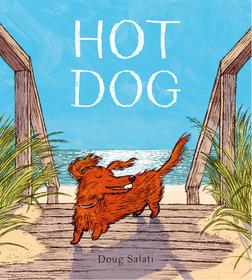
|
|
| Doug Salati | |
Author/illustrator Doug Salati just won the 2023 Caldecott Medal for his picture book, Hot Dog (Knopf Books for Young Readers).
Congratulations! What an exciting day you must be having! How are you feeling?
It is 5:45 pm and it has been a day of nonstop amazing and celebratory messages from friends, family, colleagues and enthusiastic fans of the book. That is a lot of love. I feel extremely fortunate and grateful and happy.
Would you tell our readers about Hot Dog and its inspiration?
At its simplest, the book is about a dog whose owner helps it escape to the beach for some physical and emotional relief and rejuvenation. The idea came when I met a city-dog named Charlie who was having the time of his life at the beach.
This is the first picture book you both authored and illustrated. How did working on this compare with the works you've done in collaboration with other creators?
It is thrilling and daunting to get to make all the decisions. I think Maurice Sendak summed it up so beautifully when he said creating pictures for a book "involves a kind of vigorous working with the writer. Sometimes you're the writer, too, so you're working with yourself; then the difficulty and strain and joy of that particular book is the balancing between the text and the pictures."
 Looking at the illustrative style in your other books, Hot Dog stands out as being different. I keep thinking "Raúl the third meets Matthew Cordell with vibes of Ludwig Bemelmans." Is there something different about the way you illustrated this book?
Looking at the illustrative style in your other books, Hot Dog stands out as being different. I keep thinking "Raúl the third meets Matthew Cordell with vibes of Ludwig Bemelmans." Is there something different about the way you illustrated this book?
What an amazing combination of artists to be compared to. I was endeavoring to let the line stay as loose and lively as possible. And I did focus a lot on the shifting of the color, temperature and sensory feeling between city and beach, day and night.
There is an incredible sense of movement in this book: waves crash, the wind blows through blinds, the dog digs in the sand... there's even a frenetic energy in the way the panels are drawn while the woman and dog are in the city. Was this all part of the plan from the beginning?
It is wonderful you felt that. I was aiming for a lot of movement. I knew I wanted the city in the first part to feel like it was constricted and buzzing and jerky with agitation and then to let it give way to the smoothness, fluidity and flow of the water, sand and open sky.
You play with formatting quite a lot in this book using series of illustrative vignettes that require viewers to read the story sometimes left to right, sometimes vertically from top to bottom, sometimes both. Would you speak to those artistic decisions?
The panel formatting was a new way of working for me, but it seemed to be the best method to guide the reader through the sensory path of navigating a city landscape, escaping it, then returning home. In one place, we are hemmed in by vertical structure, and in another there was nothing but an expansive stretch of space.
And, of course, why a hot dog?
I wanted our long and low protagonist to be in opposition to its tall owner and the towering verticality of the city. And then to be able to shift so perfectly in parallel to the long horizon line of the beach.
Are you working on anything new?
I am excited to be currently illustrating a collection of poems by Matthew Burgess and the sequel to a new middle-grade novel by Elaine Dimopoulos.
Is there anything else you'd like to tell Shelf Awareness readers?
Thank you for reading! --Siân Gaetano, children's and YA editor, Shelf Awareness

